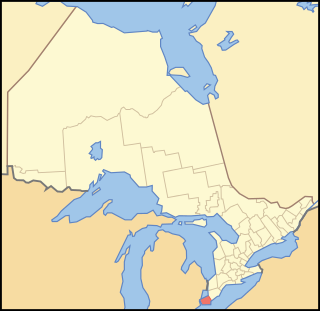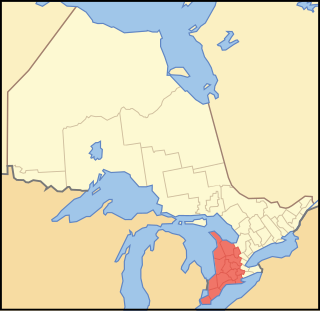Related Research Articles

Essex County is a primarily rural county in Southwestern Ontario, Canada comprising seven municipalities: Amherstburg, Kingsville, Lakeshore, LaSalle, Leamington, Tecumseh and the administrative seat, Essex. Essex County has a population of 181,530 as of the Canada 2016 Census.

Leamington is a municipality in Essex County, Ontario, Canada. With a population of 27,595 in the Canada 2016 Census, it is the second-largest municipality in the Windsor-Essex County area. It includes Point Pelee National Park, the southernmost point of mainland Canada.

Chatham-Kent is a single-tier municipality in Southwestern Ontario, Canada. Mostly rural, its population centres are Chatham, Wallaceburg, Tilbury, Blenheim, Ridgetown, Wheatley and Dresden. The current Municipality of Chatham-Kent was created in 1998 by the merger of Kent County and its municipalities.

Southwestern Ontario is a secondary region of Southern Ontario in the Canadian province of Ontario. It occupies most of the Ontario Peninsula bounded by Lake Huron, including Georgian Bay, to the north and northwest; the St. Clair River, Lake St. Clair, and Detroit River, to the west; and Lake Erie to the south. To the east, on land, Southwestern Ontario is bounded by Central Ontario and the Golden Horseshoe. The region had a population of 2,583,544 in 2016. It is sometimes further divided into "Midwestern Ontario" covering the eastern half of the area and the heart of Southwestern Ontario encompassing the western half of the region.

Founded in 1973, the Ontario Nurses’ Association (ONA) is the trade union that represents 60,000 registered nurses and allied health professionals working in hospitals, long-term care facilities, public health, community agencies and industry throughout the province of Ontario. ONA has more than 14,000 nursing student affiliates; all members of the Canadian Nursing Students' Association who study in the province.
Peel Memorial Hospital (PMH) was a 367-bed acute care hospital located in central Brampton, Ontario. PMH was founded in 1925 and became a part of the William Osler Health Centre in 1998. It previously served approximately 400,000 residents in Brampton and the surrounding areas. Over 96,832 patients were treated on an out-patient basis, another 70,446 residents used the 24/7 emergency department and 22,889 patients were admitted for inpatient care. The hospital employed over 1,800 professional and support personnel. There were 320 physicians as well as approximately 600 volunteers that contributed their services and fund raising efforts.

NORTH Network was a telehealth organization serving communities in Northern and Central Ontario. NORTH's head office was located in Toronto and its clinical headquarters in Timmins. NORTH was a program of Sunnybrook Health Sciences Centre, and received funding from the provincial government's Ministry of Health and Long Term Care.
Health regions, also called health authorities, are a governance model used by Canada's provincial governments to administer and deliver public health care to all Canadian residents.
Local Health Integration Networks (LHINs) are the health authorities responsible for regional administration of public healthcare services in the province of Ontario, Canada.

The Campbellford Memorial Hospital is an Ontario class C and class G 34-bed hospital in the community of Campbellford, municipality of Trent Hills, Northumberland County in central Ontario, Canada. It opened in 1953, is part of the Central East LHIN and is the largest employer in the community. The emergency department had 20,448 visits between April 2009 and Mar 2010

Frederick R. "Rick" Nicholls is a politician in Ontario, Canada. He is a Progressive Conservative member of the Legislative Assembly of Ontario who was elected in the 2011 election. He represents the riding of Chatham-Kent—Leamington.
The Waterloo Wellington LHIN is one of fourteen Local Health Integration Networks (LHINs) in the Canadian province of Ontario.
The Central West LHIN is one of fourteen Local Health Integration Networks (LHINs) in the Canadian province of Ontario.
The Mississauga Halton LHIN is a Local Health Integration Network (LHIN) in the Canadian province of Ontario. It is a community-based, non-profit organization funded by the Government of Ontario through the Ministry of Health and Long-Term Care.
The Toronto Central LHIN is one of fourteen Local Health Integration Networks (LHINs) in the Canadian province of Ontario.
Chronic disease in Northern Ontario is a population health problem. The population in Northern Ontario experiences worse outcomes on a number of important health indicators, including higher rates of chronic disease compared to the population in the rest of Ontario.
The North East LHIN is one of fourteen Local Health Integration Networks (LHINs) in the Canadian province of Ontario.
The South East LHIN is one of fourteen Local Health Integration Networks (LHINs) in the Canadian province of Ontario.
Camilla Care Community is a 236-resident long-term care home in Mississauga, Ontario, owned by Sienna Senior Living. It is located next to Trillium Health Partners' Mississauga Hospital. The facility was taken over, temporarily, by the Province of Ontario in May 2020, as a result of extensive deaths from COVID-19.
Eatonville Care Centre is a privately-owned long-term care facility in the Eatonville area of Etobicoke, Toronto, Ontario, Canada. As of 2020, it is owned by Rykka Care Centres. During the COVID-19 pandemic, it was particularly hard-hit, with 142 resident cases and 40 resident deaths. A report by the Canadian Armed Forces — who had been deployed to the facility, to assist — recorded "aggressive behaviour" by staff and drugging of residents that the Forces deemed unnecessary.